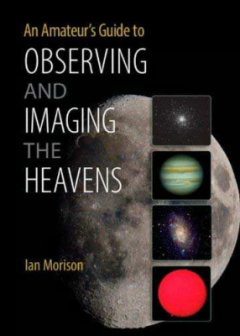An amateur’s guide to observing and imaging the heavens
| By Ian Morison | Reviewed by Martin Mobberley |
| Cambridge University Press 2014 | xiv + 321 pages |
| Price £25 (pbk) | ISBN:978-1-107-61960-9 |

Writing any technical book about modern amateur astronomy is a daunting challenge. With so much information online, and a veritable infinity of competing book titles, a bestseller in this field is any title that sells more than 500 copies! In addition, technology advances constantly, so that any book covering astronomical imaging can quickly look outdated. So, it is very fortunate that some amongst us still accept such a thankless literary challenge.
Ian Morison is a former Jodrell Bank radio astronomer, a well-known astronomy author, and the Instruments Advisor of the Society for Popular Astronomy. His weighty paperback is broken down into 18 chapters, and the first eight are solely concerned with explaining the relative merits of refractors, reflectors, binoculars, Schmidt−Cassegrains, Maksutovs, their mountings and their maintenance. Ian has put a huge amount of work into addressing the equipment basics (resolution, collimation etc.) as well as trying to keep up with the latest trends, such as sophisticated alt-az mountings. Useful figures (150+ in the book) abound, although some images are printed too dark for my liking and only a dozen are in colour.
Chapters 9 and 10 cover visual observing, but sketching techniques are not addressed. Instead, Ian first explains the performance of the human eye when observing deep sky objects, along with running through a few catalogues, star charts and modern planetarium software packages. Visual lunar and planetary observing is described mainly from a ‘What can you see?’ perspective (Martian polar caps, the Great Red Spot etc.) although suitable planetary filters are recommended. Variable star and comet observing are not covered.
The final eight chapters will probably most interest the potential purchaser, as they explain how to image the night sky. Ian has split this bewilderingly complex subject up into: Imaging the Moon and Planets (using digital cameras, DSLRs or high speed cameras), Observing and Imaging the Sun (including H-alpha work), Astro-Video work, DSLR Deep Sky Imaging, and using Cooled CCD Cameras. The final three chapters address Guiding methods, Spectral Studies and Photoshop techniques.
As a general reference book this affordable guide covers most of its intended subjects very comprehensively. However, satisfying those with specialised imaging interests, who want to secure great pictures quickly, will be more difficult. Such readers might gain most from Robert Gendler’s Lessons from the Masters, or the DVD High Resolution Astrophotography produced by Damian Peach. Even so, I would be happy to recommend this book to anyone who wants a solid overall grounding in modern astronomical telescopes, observing and imaging.
Martin, a former BAA President, has been a BAA member for 45 years and a prolific astrophotographer and imager for 34 of them. He is the author of 12 astronomy books and is threatening to write more.
| The British Astronomical Association supports amateur astronomers around the UK and the rest of the world. Find out more about the BAA or join us. |
